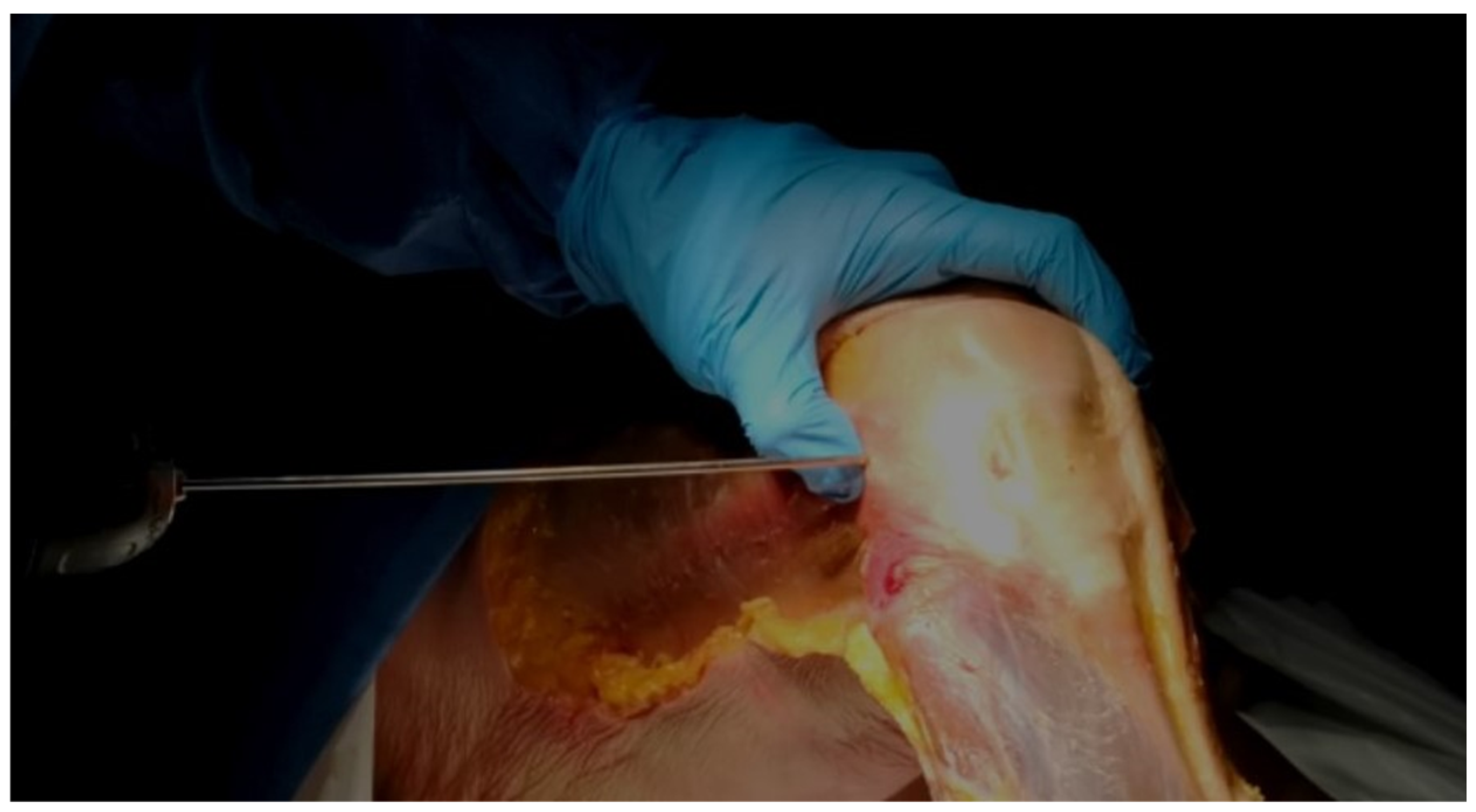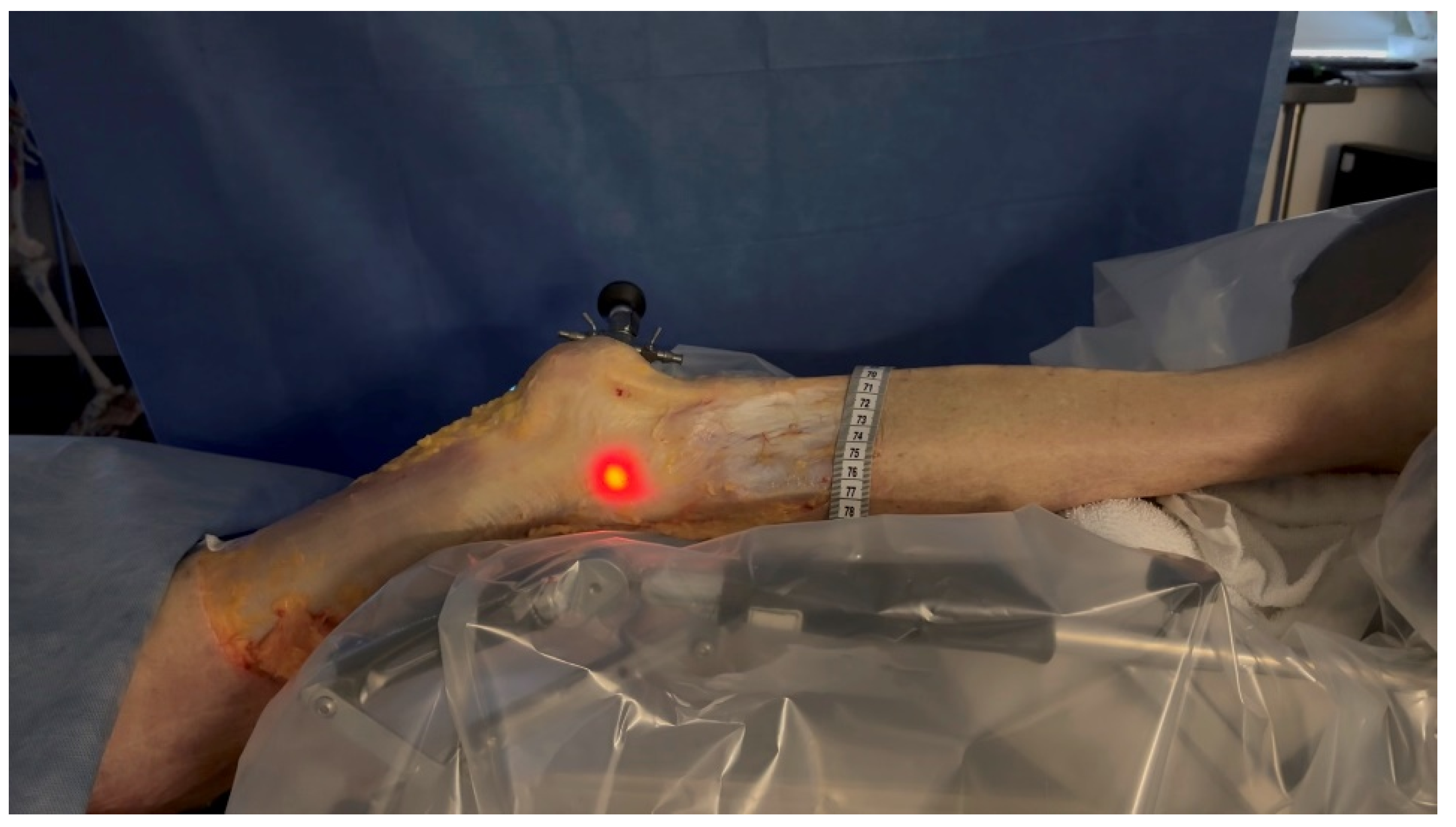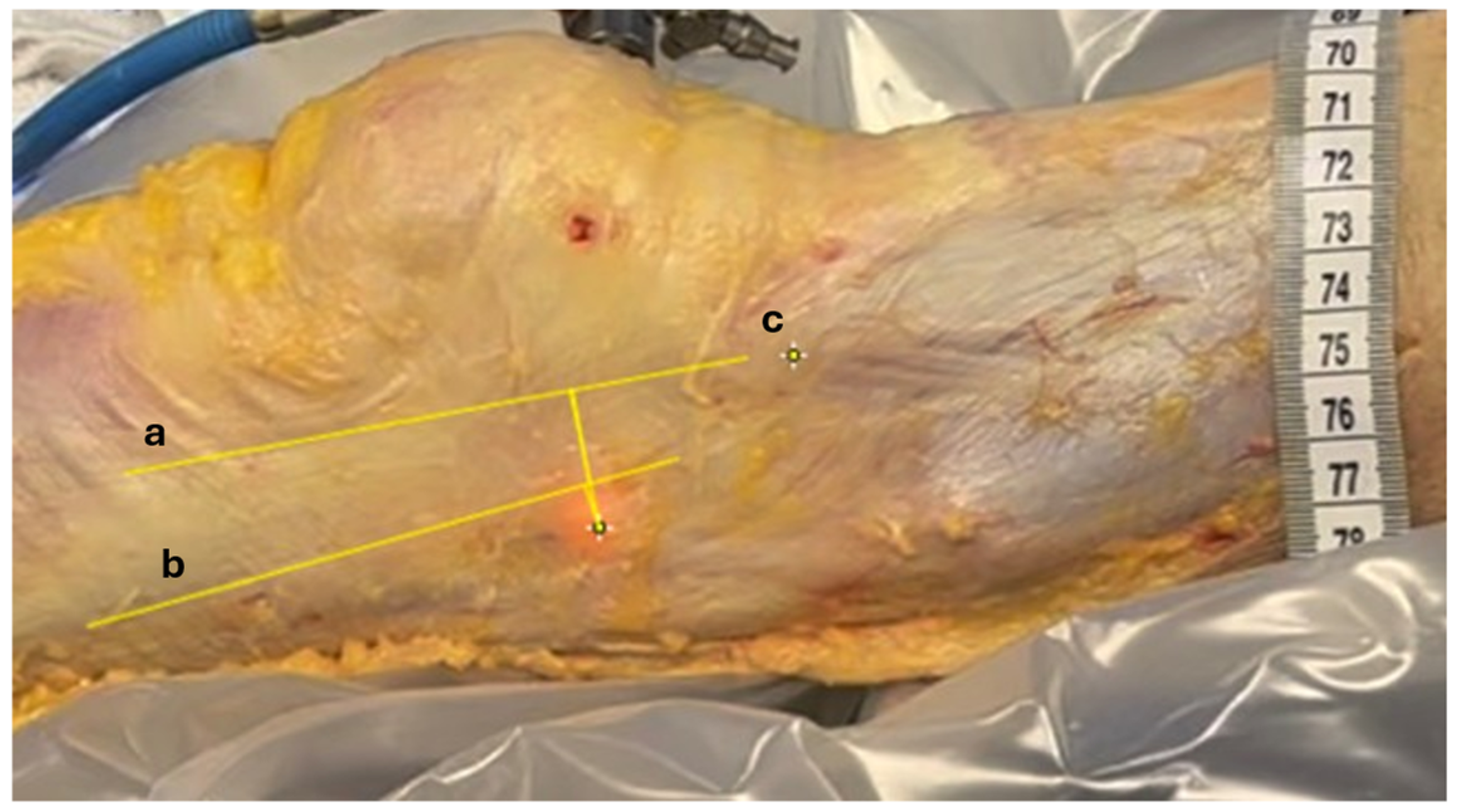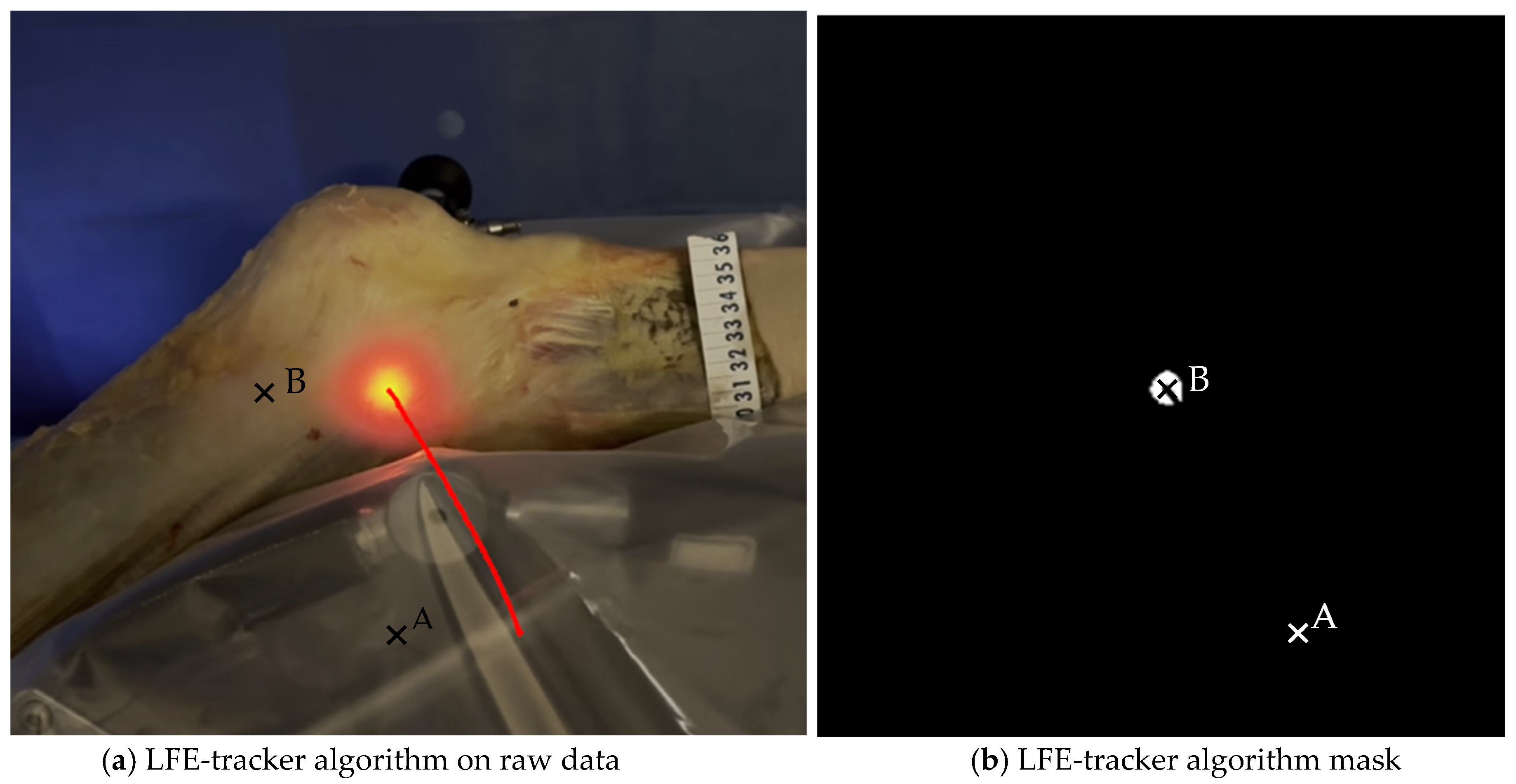The Musculoskeletal Advanced Transillumination Technique (MATT): A Descriptive Proof-of-Concept Study of a New Method for the Study of the Iliotibial Tract Tested on Fresh Cadaveric Specimens
Abstract
1. Introduction
2. Materials and Methods
2.1. Study Design
2.2. A Step-by-Step Protocol for the Musculoskeletal Advanced Transillumination Technique (MATT) for Cadaveric Specimens
- Dissection of the anterior and lateral region of the knee was carried out by one orthopedic surgeon using the same protocol for each case. He proceeded by incising a large rectangular skin flap centered on the lateral aspect of the thigh, from the femoral middle 1/3 to the tibial proximal 1/3. The knee extensor apparatus, ITB, and distal lateral hamstring insertion were exposed and cleaned of subcutaneous fatty tissue. The tITB was identified and exposed.
- The LFE was located by palpation through the ITB layer by the orthopedic surgeon.
- Using the tip of the LFE as the entry point, a 2 mm wire was inserted with a drill into the LFE from lateral to medial through the ITB. This created a transosseous femoral tunnel while preserving the structural integrity of the ITB. (Figure 1)
- The exit point on the medial femoral condyle was carefully identified and exposed. The wire was then completely removed from the medial side.
- A 2.9 mm conical arthroscopic obturator (T4902, Conmed, Clearwater, FL, USA) was used as a dilator. It was introduced into the medial femoral condyle exit hole previously created by the 2 mm wire. The obturator was then tapped in with gentle mallet blows until its tip barely emerged from the LFE as felt by palpation.
- The obturator was then removed and replaced by a 5.2 mm double-valve high-flow arthroscope sleeve (T4932, Conmed, Clearwater, FL, USA), compatible with a 2.9 mm, 30° arthroscope (T2930, Conmed, Clearwater, FL, USA), loaded with its obturator. The sleeve was then gently advanced with back-and-forth rotational movements until the tip was in contact with the inner cortex of the LFE (Figure 2). After replacement of the obturator by the 30° arthroscopic lens, a 300-watt Xenon light source (LS8000, Conmed, Clearwater, FL, USA) was connected.
- Light was projected at 25% maximum intensity onto the inner cortex of the LFE. A transilluminated area became clearly visible through the overlying fibers of the fascia lata. The transilluminated zone, referred to as visual landmark point A and point B, was subsequently identified and marked on the recorded images in both positions of interest at 0° and 30° knee flexion, respectively (Figure 3).
- The leg was then placed on a Kinetec Optima knee Continuous Passive Motion (CPM) device (S & U Medizintechnik GmbH, Zotzenheim, Germany), which allowed standardized passive knee extension–flexion cycles ranging from 0° to 30° at a constant angular velocity of 3° per second. Patellar orientation was maintained horizontally to ensure neutral rotation, and no straps were used to preserve unrestricted hip motion in both sagittal and coronal planes (Figure 4).
2.3. Trocar Placement Validation
2.4. Image Acquisition and Post-Processing
2.5. Identification of Anatomical Landmarks
2.6. Data Analyses
3. Results
Trocar Placement Validation
4. Discussion
Limitations
5. Conclusions
Supplementary Materials
Author Contributions
Funding
Institutional Review Board Statement
Informed Consent Statement
Data Availability Statement
Acknowledgments
Conflicts of Interest
Abbreviations
| MATT | Musculoskeletal Advanced Transillumination Technique |
| ITB | Iliotibial Band |
| ITBS | Iliotibial Band Syndrome |
| LFE | Lateral Femoral Epicondyle |
| tITB | Tubercule of the Iliotibial Band |
| MRI | Magnetic Resonance Imaging |
| CPM | Continuous Passive Motion |
| CT Scan | Computerized Tomography Scan |
| C-arm | Fluoroscopy Image Intensifier device |
| IQR | Interquartile Range |
| AP | Antero-posterior |
References
- Sayac, G.; Goimard, A.; Klasan, A.; Putnis, S.; Bergandi, F.; Farizon, F.; Philippot, R.; Neri, T. The anatomy of Kaplan fibers. Arch. Orthop. Trauma. Surg. 2021, 141, 447–454. [Google Scholar] [CrossRef] [PubMed]
- Hyland, S.; Graefe, S.B.; Varacallo, M.A. Varacallo Anatomy, Bony Pelvis and Lower Limb, Iliotibial Band (Tract). In StatPearls; StatPearls Publishing: Treasure Island, FL, USA, 2020. Available online: http://www.ncbi.nlm.nih.gov/books/NBK537097/ (accessed on 28 January 2021).
- Fairclough, J.; Hayashi, K.; Toumi, H.; Lyons, K.; Bydder, G.; Phillips, N.; Best, T.M.; Benjamin, M. The functional anatomy of the iliotibial band during flexion and extension of the knee: Implications for understanding iliotibial band syndrome. J. Anat. 2006, 208, 309–316. [Google Scholar] [CrossRef] [PubMed]
- Hutchinson, L.A.; Lichtwark, G.A.; Willy, R.W.; Kelly, L.A. The Iliotibial Band: A Complex Structure with Versatile Functions. Sports Med. Auckl. Nz 2022, 52, 995–1008. [Google Scholar] [CrossRef] [PubMed]
- Eng, C.M.; Arnold, A.S.; Lieberman, D.E.; Biewener, A.A. The capacity of the human iliotibial band to store elastic energy during running. J. Biomech. 2015, 48, 3341–3348. [Google Scholar] [CrossRef] [PubMed]
- Baker, R.L.; Souza, R.B.; Fredericson, M. Iliotibial Band Syndrome: Soft Tissue and Biomechanical Factors in Evaluation and Treatment. PM&R 2011, 3, 550–561. [Google Scholar] [CrossRef]
- Orchard, J.W.; Fricker, P.A.; Abud, A.T.; Mason, B.R. Biomechanics of Iliotibial Band Friction Syndrome in Runners. Am. J. Sports Med. 1996, 24, 375–379. [Google Scholar] [CrossRef] [PubMed]
- Ellis, R.; Hing, W.; Reid, D. Iliotibial band friction syndrome—A systematic review. Man. Ther. 2007, 12, 200–208. [Google Scholar] [CrossRef] [PubMed]
- Jelsing, E.J.; Finnoff, J.T.; Cheville, A.L.; Levy, B.A.; Smith, J. Sonographic evaluation of the iliotibial band at the lateral femoral epicondyle: Does the iliotibial band move? J. Ultrasound Med. Off. J. Am. Inst. Ultrasound Med. 2013, 32, 1199–1206. [Google Scholar] [CrossRef] [PubMed]
- Mündermann, L.; Corazza, S.; Andriacchi, T.P. The evolution of methods for the capture of human movement leading to markerless motion capture for biomechanical applications. J. Neuroeng. Rehabil. 2006, 3, 6. [Google Scholar] [CrossRef] [PubMed]
- Wang, L.; Jacques, S.L.; Zheng, L. MCML—Monte Carlo modeling of light transport in multi-layered tissues. Comput. Methods Programs Biomed. 1995, 47, 131–146. [Google Scholar] [CrossRef] [PubMed]
- Piechota, M.; Maczuch, J.; Skupiński, J.; Kukawska-Sysio, K.; Wawrzynek, W. Internal snapping hip syndrome in dynamic ultrasonography. J. Ultrason. 2016, 16, 296–303. [Google Scholar] [CrossRef] [PubMed]
- Walsh, G.; Archibald, C.G. MRI in greater trochanter pain syndrome. Australas. Radiol. 2003, 47, 85–87. [Google Scholar] [CrossRef] [PubMed]
- Łasecki, M.; Olchowy, C.; Pawluś, A.; Zaleska-Dorobisz, U. The Snapping Elbow Syndrome as a Reason for Chronic Elbow Neuralgia in a Tennis Player—MR, US and Sonoelastography Evaluation. Pol. J. Radiol. 2014, 79, 467–471. [Google Scholar] [CrossRef] [PubMed]
- Rioux-Forker, D.; Bridgeman, J.; Brogan, D.M. Snapping Triceps Syndrome. J. Hand Surg. 2018, 43, e1–e90. [Google Scholar] [CrossRef] [PubMed]
- Subramaniyam, S.D.; Purushothaman, R.; Zacharia, B. Snapping wrist due to multiple accessory tendon of first extensor compartment. Int. J. Surg. Case Rep. 2017, 42, 182–186. [Google Scholar] [CrossRef] [PubMed]
- Swann, R.P.; Noureldin, M.; Kakar, S. Dorsal Radiotriquetral Ligament Snapping Wrist Syndrome—A Novel Presentation and Review of Literature: Case Report. J. Hand Surg. 2016, 41, 344–347.e2. [Google Scholar] [CrossRef] [PubMed]
- Bollen, S.R.; Arvinte, D. Snapping pes syndrome: A report of four cases. J. Bone Joint Surg. Br. 2008, 90, 334–335. [Google Scholar] [CrossRef] [PubMed]
- Shapiro, S.A.; Hernandez, L.O.; Montero, D.P. Snapping Pes Anserinus and the Diagnostic Utility of Dynamic Ultrasound. J. Clin. Imaging Sci. 2017, 7, 39. [Google Scholar] [CrossRef] [PubMed]
- Lokiec, F.; Velkes, S.; Schindler, A.; Pritsch, M. The snapping biceps femoris syndrome. Clin. Orthop. 1992, 283, 205–206. [Google Scholar] [CrossRef]
- Krause, D.A.; Stuart, M.J. Snapping popliteus tendon in a 21-year-old female. J. Orthop. Sports Phys. Ther. 2008, 38, 191–195. [Google Scholar] [CrossRef] [PubMed]










| Donors | 1 | 2 | 3 | 4 |
|---|---|---|---|---|
| Age (years) | 76 | 75 | 72 | 69 |
| Sex | F | M | M | M |
| Time since death (days) | 47 | 7 | 25 | 27 |
| N | Minimum | Maximum | Median | IQR | |
|---|---|---|---|---|---|
| Absolute LFE displacement from 0° to 30° (mm) | 8 | 1.94 | 14.95 | 9.18 | 7.23–10.95 |
| Distance between LFE and posterior margin ITB at 0° (mm) | 8 | −12.32 | 13.39 | 2.72 | −8.80–5.95 |
| Distance between LFE and posterior margin ITB at 30° (mm) | 8 | −15.27 | 19.13 | −6.23 | −11.77–11.49 |
| Mean change between LFE and posterior margin ITB (mm) | 8 | −13.8 | 16.26 | −1.76 | −10.28–8.72 |
| Distance between LFE and anterior margin ITB at 0° (mm) | 8 | 7.50 | 28.20 | 13.24 | 8.84–22.10 |
| Distance between LFE and anterior margin ITB at 30° (mm) | 8 | 5.73 | 35.32 | 9.29 | 7.69–30.58 |
| Mean change between LFE and anterior margin ITB (mm) | 8 | 6.61 | 31.76 | 11.26 | 8.27–26.33 |
| Distance between LFE and tITB at 0° (mm) | 8 | 39.71 | 55.83 | 51.98 | 49.13–52.36 |
| Distance between LFE and tITB at 30° (mm) | 8 | 45.44 | 63.67 | 53.66 | 50.08–60.11 |
| Mean change in LFE–tITB distance during knee flexion from 0° and 30° (mm) | 8 | 1.64 | 8.08 | 3.92 | 2.48–5.73 |
| Donor #1 (mm) | Donor #2 (mm) | ||
|---|---|---|---|
| Left | Right | Left | Right |
| 6.7 | 0.7 | 1.1 | 1.6 |
Disclaimer/Publisher’s Note: The statements, opinions and data contained in all publications are solely those of the individual author(s) and contributor(s) and not of MDPI and/or the editor(s). MDPI and/or the editor(s) disclaim responsibility for any injury to people or property resulting from any ideas, methods, instructions or products referred to in the content. |
© 2025 by the authors. Licensee MDPI, Basel, Switzerland. This article is an open access article distributed under the terms and conditions of the Creative Commons Attribution (CC BY) license (https://creativecommons.org/licenses/by/4.0/).
Share and Cite
Bédard, S.; Bédard, A.; Gaudreault, N.; Izzo, M.; Vézina, F. The Musculoskeletal Advanced Transillumination Technique (MATT): A Descriptive Proof-of-Concept Study of a New Method for the Study of the Iliotibial Tract Tested on Fresh Cadaveric Specimens. J. Funct. Morphol. Kinesiol. 2025, 10, 327. https://doi.org/10.3390/jfmk10030327
Bédard S, Bédard A, Gaudreault N, Izzo M, Vézina F. The Musculoskeletal Advanced Transillumination Technique (MATT): A Descriptive Proof-of-Concept Study of a New Method for the Study of the Iliotibial Tract Tested on Fresh Cadaveric Specimens. Journal of Functional Morphology and Kinesiology. 2025; 10(3):327. https://doi.org/10.3390/jfmk10030327
Chicago/Turabian StyleBédard, Sonia, Alexandre Bédard, Nathaly Gaudreault, Matteo Izzo, and François Vézina. 2025. "The Musculoskeletal Advanced Transillumination Technique (MATT): A Descriptive Proof-of-Concept Study of a New Method for the Study of the Iliotibial Tract Tested on Fresh Cadaveric Specimens" Journal of Functional Morphology and Kinesiology 10, no. 3: 327. https://doi.org/10.3390/jfmk10030327
APA StyleBédard, S., Bédard, A., Gaudreault, N., Izzo, M., & Vézina, F. (2025). The Musculoskeletal Advanced Transillumination Technique (MATT): A Descriptive Proof-of-Concept Study of a New Method for the Study of the Iliotibial Tract Tested on Fresh Cadaveric Specimens. Journal of Functional Morphology and Kinesiology, 10(3), 327. https://doi.org/10.3390/jfmk10030327






